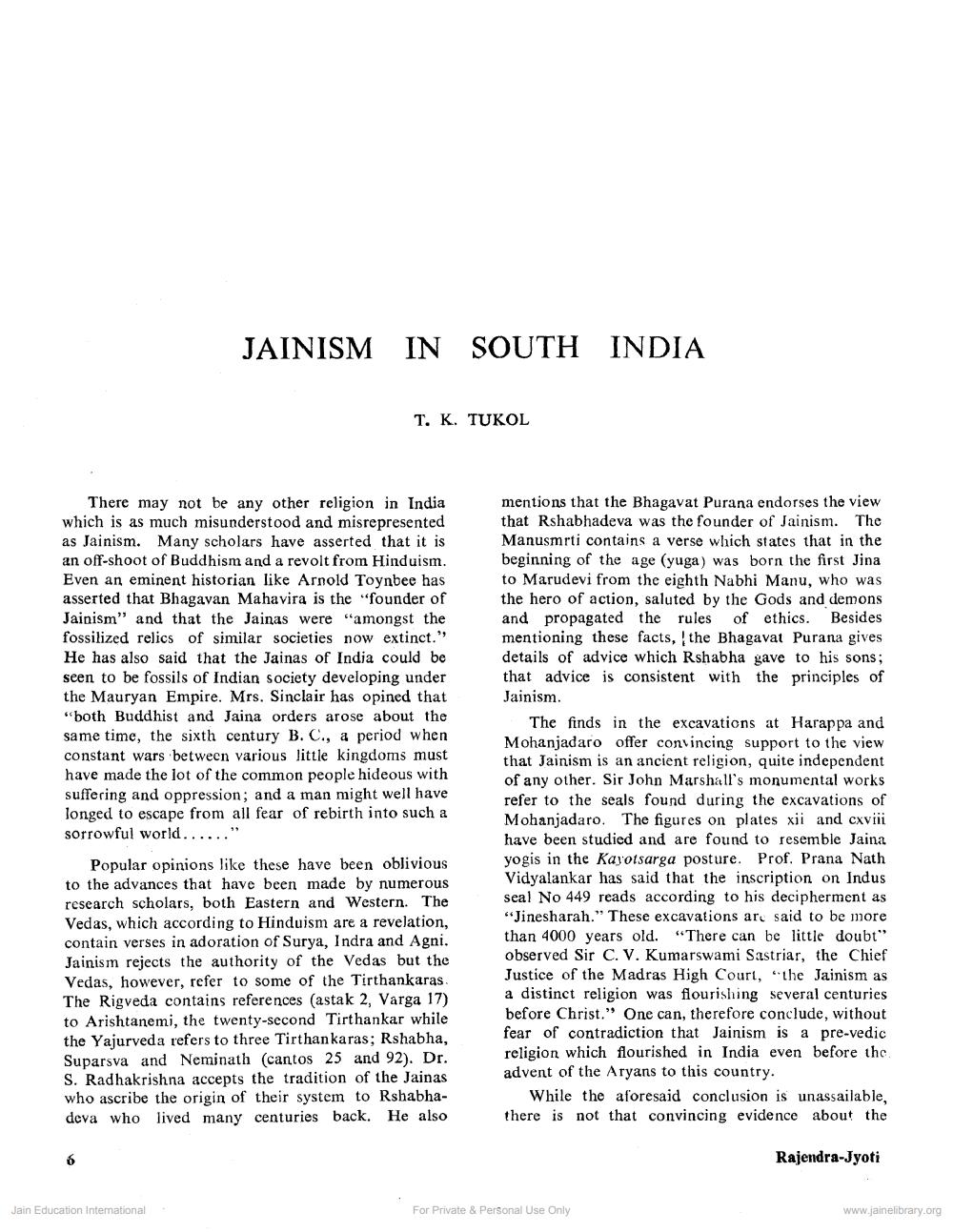Book Title: Jainism in South India Author(s): T K Tukol Publisher: Z_Rajendrasuri_Janma_Sardh_Shatabdi_Granth_012039.pdf View full book textPage 1
________________ JAINISM IN SOUTH There may not be any other religion in India which is as much misunderstood and misrepresented as Jainism. Many scholars have asserted that it is an off-shoot of Buddhism and a revolt from Hinduism. Even an eminent historian like Arnold Toynbee has asserted that Bhagavan Mahavira is the "founder of Jainism" and that the Jainas were "amongst the fossilized relics of similar societies now extinct." He has also said that the Jainas of India could be seen to be fossils of Indian society developing under the Mauryan Empire. Mrs. Sinclair has opined that "both Buddhist and Jaina orders arose about the same time, the sixth century B. C., a period when constant wars between various little kingdoms must have made the lot of the common people hideous with suffering and oppression; and a man might well have longed to escape from all fear of rebirth into such a sorrowful world......" 6 T. K. TUKOL Popular opinions like these have been oblivious to the advances that have been made by numerous research scholars, both Eastern and Western. The Vedas, which according to Hinduism are a revelation, contain verses in adoration of Surya, Indra and Agni. Jainism rejects the authority of the Vedas but the Vedas, however, refer to some of the Tirthankaras. The Rigveda contains references (astak 2, Varga 17) to Arishtanemi, the twenty-second Tirthankar while the Yajurveda refers to three Tirthankaras; Rshabha, Suparsva and Neminath (cantos 25 and 92). Dr. S. Radhakrishna accepts the tradition of the Jainas who ascribe the origin of their system to Rshabhadeva who lived many centuries back. He also Jain Education International INDIA mentions that the Bhagavat Purana endorses the view that Rshabhadeva was the founder of Jainism. The Manusmrti contains a verse which states that in the beginning of the age (yuga) was born the first Jina to Marudevi from the eighth Nabhi Manu, who was the hero of action, saluted by the Gods and demons and propagated the rules of ethics. Besides mentioning these facts, the Bhagavat Purana gives details of advice which Rshabha gave to his sons; that advice is consistent with the principles of Jainism. The finds in the excavations at Harappa and Mohanjadaro offer convincing support to the view that Jainism is an ancient religion, quite independent of any other. Sir John Marshall's monumental works refer to the seals found during the excavations of Mohanjadaro. The figures on plates xii and cxviii have been studied and are found to resemble Jaina yogis in the Kayotsarga posture. Prof. Prana Nath Vidyalankar has said that the inscription on Indus seal No 449 reads according to his decipherment as "Jinesharah." These excavations are said to be more than 4000 years old. "There can be little doubt" observed Sir C. V. Kumarswami Sastriar, the Chief Justice of the Madras High Court, the Jainism as a distinct religion was flourishing several centuries before Christ." One can, therefore conclude, without fear of contradiction that Jainism is a pre-vedic religion which flourished in India even before the advent of the Aryans to this country. While the aforesaid conclusion is unassailable, there is not that convincing evidence about the Rajendra-Jyoti For Private & Personal Use Only www.jainelibrary.orgPage Navigation
1 2 3 4 5 6
